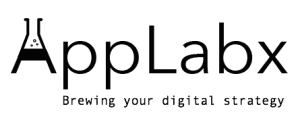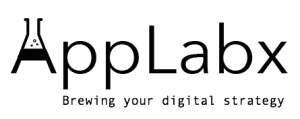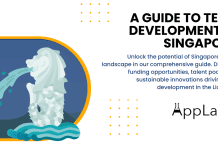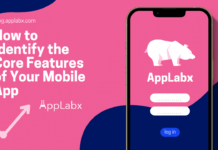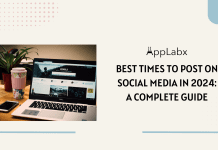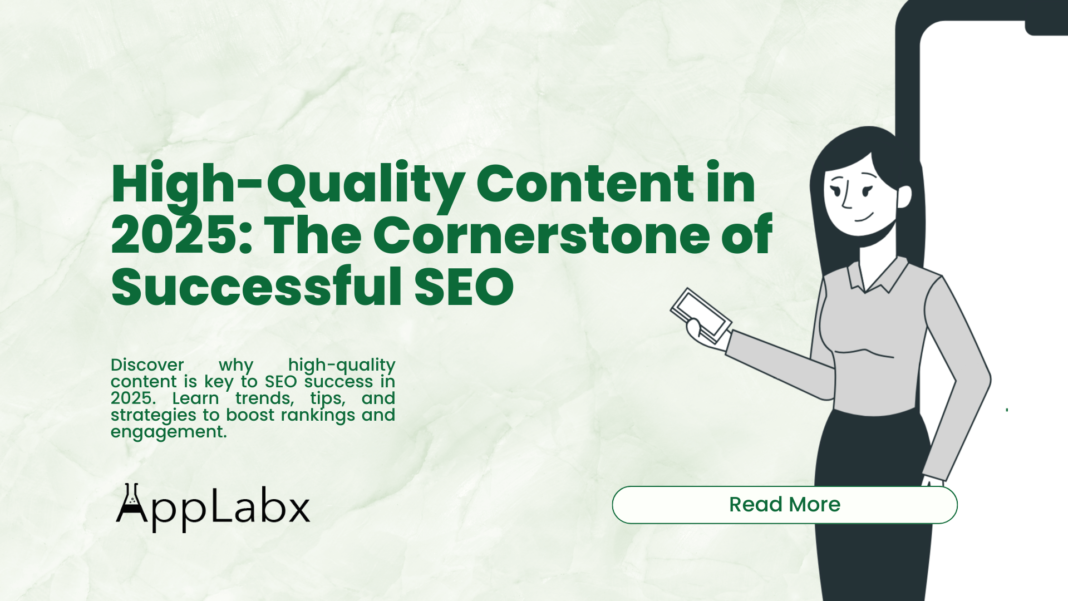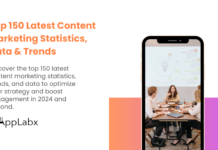Key Takeaways
- Quality Over Quantity: In 2025, search engines prioritize in-depth, relevant, and user-focused content over keyword-stuffed articles, driving higher rankings and engagement.
- AI and Personalization: AI will play a pivotal role in content creation, but human oversight is essential to maintain authenticity. Personalized content will become crucial for meeting user needs and enhancing conversions.
- Multimedia and Interactivity: Incorporating visuals, videos, and interactive elements into your content will significantly boost user engagement, making your site more appealing to both users and search engines.
In the ever-evolving world of digital marketing, one element has remained a constant driver of success: content. But not just any content—high-quality content.
As we step into 2025, the role of high-quality content has become more critical than ever, solidifying its place as the cornerstone of successful SEO strategies.
With search engine algorithms becoming increasingly sophisticated and user expectations continuing to rise, content that informs, engages, and delivers value is no longer optional; it’s essential.
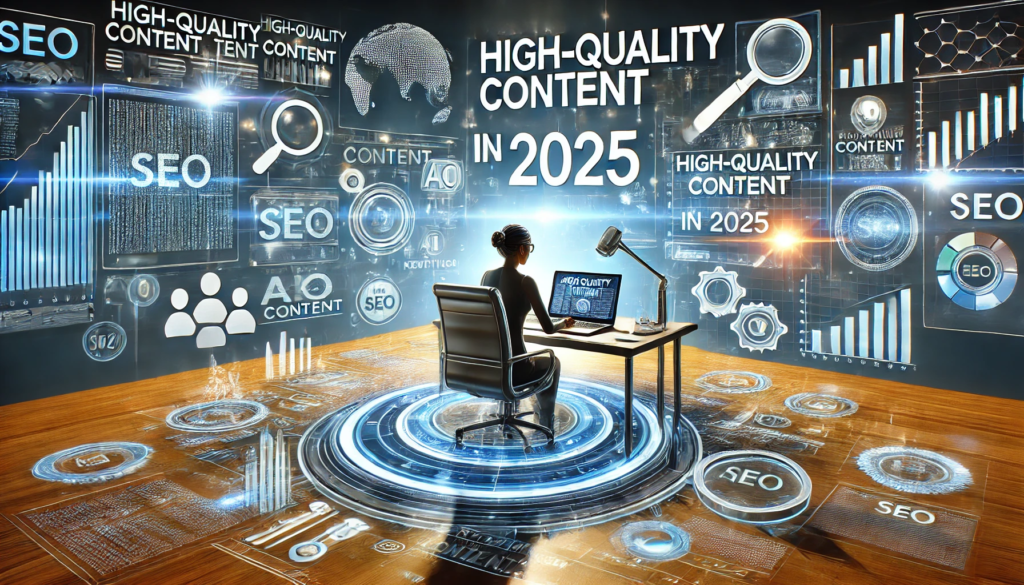
The digital landscape in 2025 is characterized by an overwhelming amount of information.
Every day, millions of blog posts, videos, and social media updates flood the internet, creating an unprecedented level of competition for visibility.
In this crowded space, how can brands, businesses, and creators ensure their content stands out? The answer lies in producing content that not only aligns with search engine guidelines but also resonates deeply with audiences.
Google and other search engines have refined their algorithms to prioritize user experience above all else. This means that superficial content stuffed with keywords or vague platitudes no longer suffices.
Today, users and search engines alike demand content that is relevant, credible, and engaging. Enter high-quality content—a dynamic blend of expertise, authenticity, and strategic optimization that meets users’ needs while satisfying algorithmic expectations.
Moreover, the rise of AI-driven tools and evolving search habits, such as voice search and visual search, has reshaped how people discover and consume information online.
In 2025, SEO is no longer about simply ranking for keywords; it’s about creating a meaningful connection with your audience. Content must answer questions, solve problems, and inspire action, all while being tailored to individual preferences and contexts.
This shift toward user-centric content creation is further reinforced by Google’s continued emphasis on E-EA-T (Expertise, Experience, Authoritativeness, and Trustworthiness).
These four pillars now serve as a guiding framework for determining content quality.
But achieving E-E-A-T is not just about adding a byline or citing a few sources. It involves consistently delivering value, building credibility over time, and demonstrating your authority in a given niche.
So, why is 2025 such a pivotal year for high-quality content in SEO? The reasons are manifold. With advancements in AI and machine learning, search engines can now assess content quality more effectively than ever before.
Meanwhile, users are becoming more discerning, expecting personalized, visually engaging, and easily digestible content. This convergence of smarter algorithms and higher user expectations makes high-quality content the non-negotiable foundation for any successful SEO strategy.
This blog will explore the critical components that define high-quality content in 2025, the challenges creators face, and actionable strategies to stay ahead in the game.
From understanding Google’s latest algorithm updates to leveraging cutting-edge tools for content creation, we’ll uncover the insights you need to thrive in an increasingly competitive digital ecosystem.
As we delve deeper into this topic, remember that the key to successful SEO isn’t just about keeping up with trends—it’s about mastering the art of creating content that truly matters.
Let’s embark on this journey to understand why high-quality content is not just the cornerstone of SEO in 2025 but the driving force behind digital success in the years to come.
But, before we venture further, we like to share who we are and what we do.
About AppLabx
From developing a solid marketing plan to creating compelling content, optimizing for search engines, leveraging social media, and utilizing paid advertising, AppLabx offers a comprehensive suite of digital marketing services designed to drive growth and profitability for your business.
AppLabx is well known for helping companies and startups use SEO to drive web traffic to their websites and web apps.
At AppLabx, we understand that no two businesses are alike. That’s why we take a personalized approach to every project, working closely with our clients to understand their unique needs and goals, and developing customized strategies to help them achieve success.
If you need a digital consultation, then send in an inquiry here.
High-Quality Content in 2025: The Cornerstone of Successful SEO
- What Defines High-Quality Content in 2025?
- The Role of AI in Shaping High-Quality Content
- Key Elements of High-Quality Content in 2025
- Challenges in Creating High-Quality Content
- Tips for Creating High-Quality Content in 2025
- The Future of High-Quality Content Beyond 2025
1. What Defines High-Quality Content in 2025?
As SEO continues to evolve, so do the expectations surrounding what constitutes high-quality content. In 2025, high-quality content is not just about satisfying search engine algorithms; it’s about delivering exceptional value to users while maintaining technical and strategic excellence. Let’s break down the key elements that define high-quality content in 2025, along with examples and actionable insights.
Relevance and Value
Ensuring content is both relevant to the audience and valuable in solving their problems or addressing their needs is foundational.
- Alignment with Search Intent:
- Content must match what users are looking for, whether informational, navigational, transactional, or commercial.
- Example: A search query like “best smartphones 2025” requires a detailed comparison guide with pros and cons, pricing, and recommendations.
- Actionable Insights:
- Provide step-by-step guides, tips, or instructions that users can implement immediately.
- Example: For “how to grow succulents indoors,” include care tips, lighting requirements, and a troubleshooting FAQ.
- Originality and Uniqueness:
- Avoid rehashing existing content; offer new perspectives, data, or case studies.
- Example: Instead of summarizing general SEO trends, create a proprietary study showcasing how businesses implemented specific trends successfully.
E-E-A-T (Expertise, Experience, Authoritativeness, Trustworthiness)
Google’s E-E-A-T guidelines remain a cornerstone of content evaluation.
- Showcasing Expertise:
- Include author bios with relevant credentials and experience.
- Example: A medical blog discussing diabetes management should be authored or reviewed by a certified endocrinologist.
- Building Authority:
- Reference reputable sources and provide links to authoritative websites.
- Example: A financial article about retirement planning might link to government resources or accredited financial institutions.
- Establishing Trustworthiness:
- Ensure factual accuracy, cite reliable sources, and avoid exaggerated claims.
- Example: Use peer-reviewed studies or official reports to back up statistics in a health-related blog.
User Engagement Metrics
Content quality is directly tied to how well it engages users and keeps them on the page.
- High Dwell Time:
- Create content that captures attention through compelling introductions, storytelling, and visually appealing layouts.
- Example: An article on “the history of space exploration” could use a timeline graphic and embed videos of key missions.
- Low Bounce Rate:
- Address user queries comprehensively to reduce the likelihood of users returning to search results.
- Example: For “best hiking trails near Denver,” include maps, trail difficulty levels, weather considerations, and gear recommendations.
- Encouraging Interactivity:
- Use polls, quizzes, and comment sections to engage users.
- Example: A recipe blog could include an interactive tool to adjust ingredient quantities based on servings.
Comprehensive and Well-Structured Information
High-quality content should be exhaustive yet easily digestible.
- In-Depth Coverage:
- Address all aspects of a topic to leave no questions unanswered.
- Example: A guide to starting a podcast should cover equipment, platforms, editing tools, and marketing strategies.
- Clear Subheadings and Formatting:
- Break content into sections with meaningful headers for readability.
- Example: A “travel tips” article could have sections like “Packing Essentials,” “Navigating Airports,” and “Safety Tips.”
- Visual Enhancements:
- Use images, infographics, and videos to complement the text.
- Example: Include step-by-step photos in a DIY furniture-building tutorial.
Technical SEO and Accessibility Compliance
High-quality content must also adhere to technical best practices to ensure it performs well.
- Mobile Optimization:
- Content should be responsive and user-friendly on mobile devices.
- Example: Ensure all images are scaled appropriately, and CTAs are easy to click on smaller screens.
- Page Speed:
- Optimize load times by compressing images and minimizing scripts.
- Example: A photography portfolio website with high-resolution images should use lazy loading to enhance performance.
- Accessibility Features:
- Make content accessible to users with disabilities by including alt text for images, proper heading structure, and transcript options for videos.
- Example: Add descriptive alt text to infographics so screen readers can interpret them accurately.
Visual and Interactive Elements
As attention spans shrink, visual and interactive content is crucial to capturing and maintaining interest.
- High-Quality Visuals:
- Use professional images, graphics, and videos to enrich content.
- Example: A fitness blog discussing workout routines could include embedded demonstration videos.
- Interactive Tools:
- Incorporate calculators, interactive maps, or augmented reality features.
- Example: A real estate website could use an AR tool for virtual property tours.
- Personalized Content Experiences:
- Tailor recommendations based on user behavior or preferences.
- Example: An e-commerce blog could suggest products based on past purchases or browsing history.
Summary
High-quality content in 2025 revolves around relevance, expertise, engagement, structure, and technical excellence. It bridges the gap between satisfying user needs and meeting search engine requirements. By focusing on these elements and incorporating examples like interactive tools, expert-driven narratives, and mobile-first designs, content creators can build trust, drive traffic, and maintain a competitive edge in the digital space.
2. The Role of AI in Shaping High-Quality Content
Artificial intelligence (AI) has transformed the digital landscape, and content creation is no exception. In 2025, AI plays a pivotal role in shaping high-quality content, not only by streamlining the content creation process but also by enhancing its relevance, personalization, and optimization. Let’s dive deep into how AI is revolutionizing high-quality content, with actionable examples and use cases.
AI-Generated Content vs. Human Expertise
While AI-generated content has made significant strides, human expertise remains irreplaceable for crafting nuanced, authoritative, and empathetic content.
- Strengths of AI-Generated Content:
- Speed and Efficiency:
- AI tools like ChatGPT or Jasper AI can produce drafts, headlines, and social media posts in seconds.
- Example: A digital marketing agency uses AI to generate ad copy variations for an A/B testing campaign.
- Basic Content Creation:
- AI excels at producing straightforward content, such as FAQs, product descriptions, and summaries.
- Example: An e-commerce site uses AI to auto-generate product descriptions for thousands of SKUs.
- Speed and Efficiency:
- Limitations of AI-Generated Content:
- Lack of Deep Insights:
- AI struggles to provide original ideas, emotional resonance, or innovative perspectives.
- Example: A blog on leadership principles would require human expertise to include personal anecdotes or motivational storytelling.
- Risk of Inaccuracies:
- Without proper human oversight, AI-generated content can include outdated or incorrect information.
- Example: An AI tool creates an article about tax laws but fails to account for recent legislative changes.
- Lack of Deep Insights:
- The Human-AI Collaboration Model:
- Combine AI for efficiency and human expertise for quality and depth.
- Example: A content marketer uses AI for outlining a blog and then adds unique insights, examples, and a compelling tone.
AI as a Research and Optimization Tool
AI is invaluable in enhancing content quality by providing actionable insights during the research and optimization phases.
- Keyword Research and Analysis:
- AI tools like SEMrush and Ahrefs leverage machine learning to identify high-performing keywords and long-tail search terms.
- Example: For a blog on “sustainable travel tips,” AI suggests related terms like “eco-friendly travel gear” or “carbon offset programs.”
- Competitor Analysis:
- AI evaluates competing content to identify gaps and opportunities.
- Example: An AI tool highlights that competitors’ articles lack video tutorials, presenting an opportunity to include them.
- SEO Content Optimization:
- AI tools like Clearscope and Surfer SEO optimize content for readability, keyword placement, and semantic relevance.
- Example: AI recommends using terms like “eco-conscious traveler” in addition to “sustainable travel” for improved ranking diversity.
- Data-Driven Insights:
- AI analyzes user behavior to suggest the type of content users prefer.
- Example: Analytics reveal that users spend more time on listicles; the content strategy shifts to producing more list-based articles.
Personalization Through AI
AI empowers content creators to tailor their work for specific audiences, enhancing engagement and relevance.
- Dynamic Content Personalization:
- AI can customize web pages or emails based on user behavior, preferences, and demographics.
- Example: An AI-driven email campaign personalizes subject lines and content based on previous purchases or interactions.
- Audience Segmentation:
- AI tools categorize audiences into distinct groups to create hyper-targeted content.
- Example: A fitness brand uses AI to segment customers into categories like “beginners,” “intermediate,” and “advanced,” tailoring workout guides accordingly.
- Chatbots and Conversational Content:
- AI-powered chatbots create real-time, conversational content to engage users.
- Example: A travel website uses a chatbot to recommend destinations, itineraries, and booking options based on user input.
Enhancing Visual and Interactive Content with AI
AI isn’t limited to text—it also plays a major role in creating and optimizing visual and interactive content.
- AI-Generated Visuals:
- Tools like DALL·E and Canva’s AI features generate custom graphics, infographics, and images.
- Example: A tech blog uses AI to create an infographic comparing the features of the latest smartphones.
- Video Content Creation and Editing:
- AI-powered video tools like Pictory and Synthesia simplify video production by generating scripts, animations, or voiceovers.
- Example: A startup uses AI to create explainer videos with synthetic voiceovers and animated visuals.
- Interactive Tools:
- AI enhances tools like calculators, quizzes, and virtual try-ons.
- Example: An interior design blog offers an AI-driven room visualizer for readers to experiment with layouts and color schemes.
AI in Predictive Analytics and Content Trends
AI can analyze data to predict trends, helping creators stay ahead of the curve.
- Content Trend Prediction:
- AI tools analyze search trends and social media activity to identify emerging topics.
- Example: AI identifies a growing interest in “AI art ethics,” prompting timely blog posts on the topic.
- Performance Forecasting:
- Predict how content will perform based on current trends and historical data.
- Example: AI predicts that a blog on “2025 digital marketing trends” will perform well in Q4 based on past seasonal patterns.
- Audience Behavior Insights:
- Understand when, where, and how users consume content.
- Example: AI suggests publishing Instagram reels between 6 PM and 8 PM for optimal engagement.
Ensuring Content Authenticity and Accuracy
AI can aid in maintaining factual accuracy and preventing plagiarism, two critical components of high-quality content.
- Fact-Checking:
- AI tools like Google Fact Check Explorer cross-reference claims with credible sources.
- Example: A health blog uses AI to verify statistics on global vaccination rates.
- Plagiarism Detection:
- AI-based plagiarism tools ensure originality.
- Example: A content writer runs their draft through Grammarly or Copyscape to check for duplicated phrases.
Summary
In 2025, AI has become a game-changer for creating, optimizing, and delivering high-quality content. From generating ideas to enhancing personalization, AI empowers creators to work smarter, not harder. However, the synergy of AI and human expertise is what truly unlocks the potential of high-quality content. By leveraging AI’s efficiency and pairing it with human creativity, empathy, and critical thinking, content creators can stay ahead in the competitive landscape of SEO and user engagement.
3. Key Elements of High-Quality Content in 2025
Creating high-quality content in 2025 requires a blend of user-centric focus, technical expertise, and creativity. As search engines become smarter and user expectations increase, content must not only provide value but also meet the demands of diverse formats, accessibility, and technical optimization. Below, we explore the key elements that define high-quality content in 2025, enriched with examples and actionable insights.
1. Relevance and Search Intent
Understanding and addressing the user’s search intent remains the foundation of high-quality content.
- Types of Search Intent:
- Informational Intent:
- Users seek knowledge or answers to specific questions.
- Example: A blog titled “How to Start a Vegetable Garden” provides step-by-step guidance, lists tools needed, and includes tips for beginners.
- Transactional Intent:
- Users are ready to make a purchase or take an action.
- Example: A product comparison article like “Best Laptops Under $1,000 in 2025” includes links to purchase and discounts.
- Navigational Intent:
- Users aim to find a specific website or page.
- Example: A branded article optimized for “LinkedIn job application tips” guides users directly to LinkedIn’s job application feature.
- Informational Intent:
- Personalization of Content:
- Tailor content to specific audience segments.
- Example: A fitness website provides separate guides for weight loss, muscle building, and endurance training.
2. Depth and Comprehensiveness
Comprehensive content leaves no questions unanswered and positions itself as a one-stop resource.
- Address All Angles of a Topic:
- Content must explore subtopics, provide examples, and include actionable steps.
- Example: A guide on “Sustainable Fashion” covers the definition, benefits, top brands, DIY tips, and the environmental impact of fast fashion.
- Data and Evidence:
- Use statistics, research studies, and expert quotes to back claims.
- Example: An article on “The Benefits of Remote Work” cites surveys from companies like Gartner or PwC to support its claims.
- Evergreen and Updated Content:
- Keep content relevant by updating it with the latest information.
- Example: A tech blog updates its “Best Smartphones of the Year” list annually to reflect new releases and trends.
3. Readability and Accessibility
Content must be easy to read and accessible to a diverse audience.
- Optimized Formatting:
- Use short paragraphs, bullet points, and subheadings to enhance readability.
- Example: A recipe article uses numbered steps, bolded key ingredients, and accompanying images for each step.
- Readable Language:
- Avoid jargon and write in a conversational tone.
- Example: A financial blog on “How to Save for Retirement” simplifies terms like “compounding interest” with relatable analogies.
- Accessibility Features:
- Ensure content is inclusive of all users, including those with disabilities.
- Example: Add alt text for images, captions for videos, and high-contrast text for better readability.
4. Visual and Interactive Content
Visual and interactive elements enhance engagement and improve content retention.
- Infographics and Charts:
- Use visuals to summarize complex data.
- Example: A marketing article includes an infographic illustrating “The Customer Journey Funnel.”
- Videos and Tutorials:
- Videos enhance understanding and make content more engaging.
- Example: A blog on “Installing Solar Panels” includes a step-by-step video tutorial alongside text instructions.
- Interactive Elements:
- Incorporate calculators, quizzes, and maps to increase interactivity.
- Example: A personal finance site includes an “EMI Calculator” to help users estimate monthly payments for loans.
5. E-A-T (Expertise, Authoritativeness, Trustworthiness)
E-A-T remains a vital ranking factor for search engines and a marker of credibility for users.
- Expert Authorship:
- Content should be created or reviewed by industry experts.
- Example: A healthcare blog on “Managing Diabetes” is written by a certified endocrinologist.
- Citations and References:
- Link to authoritative sources for supporting information.
- Example: An article on “Climate Change Effects” references reports from the IPCC or NASA.
- Transparency and Trust:
- Be clear about sponsorships, affiliations, or data sources.
- Example: A review blog states upfront that it receives affiliate commissions for certain product recommendations.
6. Mobile Optimization and User Experience
With most users accessing content via mobile devices, mobile-first design is non-negotiable.
- Responsive Design:
- Ensure content looks great and functions smoothly on all devices.
- Example: A fashion blog uses a responsive grid layout for outfit suggestions, ensuring seamless scrolling on mobile.
- Fast Load Times:
- Optimize page speed by compressing images and reducing scripts.
- Example: A travel blog reduces the size of high-resolution destination images without sacrificing quality.
- Mobile-Friendly Features:
- Use tappable CTAs and simplified navigation.
- Example: A fitness app blog includes “Download Now” buttons prominently on mobile screens.
7. SEO Optimization
High-quality content must also adhere to SEO best practices to ensure visibility.
- Keyword Integration:
- Use primary and secondary keywords naturally within the content.
- Example: An article on “Top Remote Work Tools” incorporates keywords like “best remote work software” and “virtual team tools.”
- Structured Data Markup:
- Implement schema markup to help search engines understand content context.
- Example: A recipe blog uses structured data to display cooking time, ingredients, and star ratings in search results.
- Internal and External Linking:
- Link to related articles within your website and authoritative external sources.
- Example: A cybersecurity blog links to its own guide on “Password Management Tips” and an external NIST report on cybersecurity standards.
8. Emotional Resonance and Storytelling
Content that connects emotionally with the audience builds trust and loyalty.
- Use Storytelling:
- Share personal anecdotes or case studies to create a relatable narrative.
- Example: A blog on “Overcoming Impostor Syndrome” includes real-life stories from successful entrepreneurs.
- Address Pain Points:
- Speak directly to the audience’s challenges and offer solutions.
- Example: A productivity article on “Beating Procrastination” identifies common causes and provides practical techniques like the Pomodoro method.
- Call to Action (CTA):
- End with a compelling CTA that encourages user engagement.
- Example: A sustainability blog concludes with “Join our eco-friendly community today and access exclusive tips.”
Summary
The key elements of high-quality content in 2025 encompass relevance, depth, engagement, credibility, and technical precision. By combining these factors with examples like infographics, expert-authored blogs, and mobile-optimized layouts, content creators can meet the demands of both search engines and users. High-quality content is not just about ticking SEO boxes—it’s about delivering value and building meaningful connections in an increasingly competitive digital space.
4. Challenges in Creating High-Quality Content
Producing high-quality content in 2025 comes with its own set of challenges. As user expectations rise and search engine algorithms evolve, content creators must navigate various obstacles to stay competitive. Below, we explore the key challenges in creating high-quality content, along with actionable examples and insights to overcome them.
1. Keeping Up with Evolving Search Engine Algorithms
Search engines frequently update their algorithms, making it difficult to maintain high rankings.
- Frequent Algorithm Updates:
- Search engines like Google refine their algorithms to prioritize content relevance and user experience.
- Example: In 2024, Google’s Helpful Content Update penalized low-value AI-generated content, impacting creators who over-relied on automation.
- Increased Emphasis on E-A-T:
- The need to demonstrate expertise, authoritativeness, and trustworthiness requires additional resources and expertise.
- Example: A health blog must now include input from certified medical professionals to maintain credibility.
- Solution:
- Stay updated on algorithm changes through reputable SEO resources like Google Search Central and Moz.
- Continuously audit and refine your content for quality, relevance, and authority.
2. Balancing Quality with Quantity
The pressure to publish frequently can compromise content quality.
- High Output Demand:
- Brands aim to maintain visibility by producing large volumes of content.
- Example: A tech website publishes daily articles but struggles to provide in-depth analysis due to tight deadlines.
- Content Dilution:
- Over-prioritizing quantity can lead to generic or repetitive content.
- Example: Multiple blogs on “Best Smartphones” might repeat the same information without adding new value.
- Solution:
- Focus on quality over quantity by creating fewer but more comprehensive and evergreen pieces.
- Use an editorial calendar to allocate sufficient time for research and revisions.
3. Audience Expectations and Personalization
Users expect highly relevant and personalized content, which can be challenging to deliver.
- Diverse Audience Segments:
- Catering to varied demographics requires a nuanced understanding of audience needs.
- Example: A financial blog must create separate content for students, working professionals, and retirees.
- Real-Time Personalization:
- Delivering content tailored to individual preferences demands advanced tools and data insights.
- Example: A fashion retailer uses AI to recommend articles on trends based on a user’s browsing history.
- Solution:
- Leverage audience analytics tools like Google Analytics or HubSpot to understand user preferences.
- Invest in AI-driven personalization platforms to tailor content dynamically.
4. Managing AI Integration
While AI can enhance content creation, over-reliance or improper use can compromise quality.
- Over-Automation Risks:
- Excessive AI use can result in repetitive or generic content lacking originality.
- Example: An AI-generated blog on “Healthy Eating Tips” includes inaccurate advice due to lack of human oversight.
- Ethical and Authenticity Concerns:
- Users and search engines prioritize authentic, human-driven content over AI-generated pieces.
- Example: A travel blog loses credibility for publishing AI-generated reviews that don’t match real customer experiences.
- Solution:
- Use AI as a tool to augment, not replace, human creativity.
- Employ human editors to review and refine AI-generated drafts.
5. Staying Updated with Trends and Technology
The digital landscape evolves rapidly, making it challenging to stay relevant.
- Emerging Content Formats:
- Video, interactive tools, and immersive technologies like AR/VR are becoming standard.
- Example: A real estate website struggles to adopt 3D virtual tours, which are increasingly popular.
- Shifting User Preferences:
- Users demand diverse formats, such as podcasts or short-form videos.
- Example: A fitness brand producing only text blogs misses engagement opportunities on platforms like TikTok or YouTube.
- Solution:
- Regularly experiment with new formats and platforms.
- Follow industry leaders to identify emerging trends and technologies.
6. Ensuring Accuracy and Authority
Maintaining factual accuracy and credibility is crucial but often challenging.
- Complex Topics:
- Creating content on technical or specialized topics requires expertise and meticulous research.
- Example: A cybersecurity blog faces difficulties explaining encryption protocols in layman’s terms.
- Outdated Information:
- Content becomes obsolete quickly in fast-moving industries.
- Example: An article on “Top Marketing Tools” includes tools that are no longer supported in 2025.
- Solution:
- Collaborate with subject matter experts for technical accuracy.
- Regularly update content to reflect the latest developments and data.
7. Overcoming Content Saturation
Standing out in an oversaturated market requires innovation and creativity.
- Competition:
- Most topics have been extensively covered, making differentiation difficult.
- Example: Numerous blogs already address “How to Improve SEO,” resulting in repetitive content.
- Reader Fatigue:
- Users quickly lose interest in overused formats or topics.
- Example: Listicles may no longer perform well if they lack fresh perspectives.
- Solution:
- Identify content gaps by analyzing competitors and user feedback.
- Focus on unique angles, storytelling, and proprietary research to differentiate your content.
8. Time and Resource Constraints
High-quality content requires significant time, resources, and expertise.
- Limited Budgets:
- Small businesses and startups may struggle to allocate resources for content creation.
- Example: A startup lacks the budget to hire professional writers or graphic designers.
- Time-Consuming Process:
- Research, writing, editing, and optimization take substantial effort.
- Example: A single in-depth blog on “The Future of AI” may require weeks to produce.
- Solution:
- Outsource to freelance experts or agencies for specialized content needs.
- Use project management tools like Trello or Asana to streamline workflows and improve efficiency.
9. Maintaining Engagement Across Platforms
With users scattered across various platforms, creating cohesive yet platform-specific content is a challenge.
- Platform-Specific Strategies:
- Content must be tailored to suit the unique dynamics of platforms like LinkedIn, Instagram, or TikTok.
- Example: A brand publishes professional case studies on LinkedIn but struggles to create visually engaging Instagram posts.
- Consistency Across Channels:
- Maintaining a consistent brand voice while adapting to platform nuances can be tricky.
- Example: A lifestyle blog uses an informal tone on Facebook but requires a professional tone on its website.
- Solution:
- Develop a multichannel content strategy with clear objectives for each platform.
- Use tools like Buffer or Hootsuite to schedule and manage content across platforms.
Summary
Creating high-quality content in 2025 involves navigating numerous challenges, from evolving search algorithms to rising user expectations. By addressing these challenges strategically—through continuous learning, leveraging technology, and prioritizing authenticity—content creators can maintain their competitive edge. High-quality content remains a cornerstone of successful SEO, but it requires consistent effort, adaptability, and innovation to overcome the hurdles of a dynamic digital landscape.
5. Tips for Creating High-Quality Content in 2025
Producing high-quality content in 2025 requires a combination of strategic planning, advanced tools, and a deep understanding of audience needs. Here are actionable tips to ensure your content not only meets but exceeds expectations.
1. Understand and Prioritize User Intent
Knowing what your audience wants is the foundation of effective content creation.
- Research Search Intent:
- Identify the purpose behind user searches (informational, transactional, or navigational).
- Example: For a query like “Best productivity apps,” create a listicle featuring app comparisons, pros, cons, and pricing.
- Create Audience Personas:
- Develop detailed profiles for your target audience.
- Example: A fitness blog creates personas like “new moms looking for postpartum workouts” or “professionals seeking quick exercise routines.”
- Engage Through Polls and Surveys:
- Ask your audience directly about their preferences.
- Example: Use Instagram polls to determine the next blog topic or ask for feedback via email newsletters.
2. Focus on Comprehensive and Evergreen Content
Depth and longevity are key to ensuring content remains valuable over time.
- Cover Topics in Detail:
- Address all subtopics, questions, and angles within a single post.
- Example: A guide on “Digital Marketing Strategies” includes sections on SEO, PPC, social media, and content marketing.
- Update Regularly:
- Keep evergreen content current with fresh data, examples, and trends.
- Example: Refresh an article on “Top SEO Trends” annually with insights on emerging technologies like AI and voice search.
- Use Cornerstone Content:
- Develop flagship articles that serve as the foundation of your content strategy.
- Example: A travel site maintains a comprehensive “Ultimate Travel Guide to Europe” and links to specific country guides.
3. Incorporate Visual and Interactive Elements
Multimedia content enhances engagement and retention.
- Use High-Quality Images and Infographics:
- Visuals help simplify complex ideas.
- Example: Include an infographic summarizing “The Benefits of Remote Work” in an HR blog.
- Embed Videos:
- Provide tutorials, case studies, or demonstrations through videos.
- Example: A beauty blog embeds a step-by-step skincare routine video alongside the text.
- Interactive Tools:
- Add quizzes, calculators, or interactive maps.
- Example: A financial blog features a “Retirement Savings Calculator” to help readers plan better.
4. Leverage AI for Efficiency Without Compromising Authenticity
AI tools can accelerate the content creation process but must be used judiciously.
- AI-Assisted Research:
- Use tools like ChatGPT or Jasper for topic generation and initial drafts.
- Example: Generate a content outline for “Top Digital Nomad Destinations” and refine it manually.
- Content Optimization Tools:
- Use platforms like Grammarly for proofreading and Surfer SEO for keyword optimization.
- Example: An article on “Eco-Friendly Living” uses AI to improve readability and integrate SEO keywords.
- Maintain Human Oversight:
- Ensure final content reflects brand voice and authenticity.
- Example: A blog on “Mental Health Tips” undergoes human review to ensure sensitivity and accuracy.
5. Optimize for Search Engines
SEO remains a cornerstone of content visibility.
- Use Strategic Keywords:
- Research primary and long-tail keywords to target niche audiences.
- Example: Instead of “best shoes,” target “best running shoes for flat feet in 2025.”
- Implement Structured Data Markup:
- Add schema for rich snippets.
- Example: A recipe blog includes structured data to display cook time, ingredients, and user ratings in search results.
- Optimize Meta Tags and Headlines:
- Use compelling and keyword-rich titles and meta descriptions.
- Example: Title: “10 Game-Changing Productivity Apps to Try in 2025”
Meta Description: “Boost efficiency with these must-have productivity tools. Explore their features, pricing, and benefits!”
6. Ensure Accessibility for All Audiences
Content should be inclusive and accessible to users with diverse needs.
- Add Alt Text for Images:
- Provide descriptive alt text for better accessibility and SEO.
- Example: Alt text for an image of a hiking trail: “A scenic view of a forest trail during autumn, ideal for nature enthusiasts.”
- Use Descriptive Captions for Videos:
- Include closed captions or transcripts.
- Example: A tutorial video on “How to Cook Vegan Lasagna” features subtitles for hearing-impaired users.
- Adopt Mobile-Friendly Designs:
- Ensure content is responsive and loads quickly on all devices.
- Example: A blog uses large fonts, easy-to-tap buttons, and compressed images for better mobile experience.
7. Write with Authenticity and Authority
Trust is critical for audience engagement and SEO.
- Collaborate with Experts:
- Involve subject matter experts to boost credibility.
- Example: A finance article on “Cryptocurrency Investing” includes quotes from blockchain specialists.
- Cite Reliable Sources:
- Use authoritative references to support claims.
- Example: A healthcare blog links to studies from the World Health Organization (WHO) or CDC.
- Maintain Transparency:
- Disclose sponsorships and affiliations clearly.
- Example: A tech review blog states it earns affiliate commissions for product recommendations.
8. Foster Engagement and Build Community
Engagement metrics like comments and shares signal content quality to search engines.
- Encourage Reader Interaction:
- Pose questions or include CTAs inviting feedback.
- Example: End an article on “Home Organization Tips” with: “What’s your favorite decluttering strategy? Share in the comments!”
- Build Social Media Presence:
- Promote content actively across platforms.
- Example: A food blogger shares blog excerpts on Instagram Stories with swipe-up links to the full recipe.
- Host Webinars and Live Sessions:
- Create opportunities for real-time audience interaction.
- Example: An educational blog hosts a live Q&A session on “Preparing for College Admissions.”
9. Monitor and Analyze Performance
Regular performance analysis helps refine content strategies.
- Track Key Metrics:
- Use tools like Google Analytics to measure traffic, bounce rates, and engagement.
- Example: Analyze which blogs drive the most conversions on an e-commerce site.
- Test and Iterate:
- Experiment with headlines, formats, and CTAs to improve results.
- Example: A travel blog A/B tests two versions of a guide: one with videos and one with images.
- Gather User Feedback:
- Conduct polls or collect comments to understand content effectiveness.
- Example: A SaaS blog surveys readers to identify gaps in their onboarding content.
Summary
Creating high-quality content in 2025 demands a mix of user-centric approaches, technical optimization, and strategic use of tools like AI. By understanding user intent, leveraging multimedia, ensuring accessibility, and continuously analyzing performance, content creators can produce impactful, engaging, and SEO-friendly content that stands out in a competitive landscape.
6. The Future of High-Quality Content Beyond 2025
As technology evolves and user expectations grow, the standards for high-quality content will continue to shift. The future of content creation will revolve around immersive technologies, hyper-personalization, and ethical considerations. This section explores trends that will define high-quality content in the years ahead and actionable steps to prepare for these changes.
1. Integration of Advanced Technologies
Technological advancements will redefine how content is created, consumed, and optimized.
- AI-Generated Content with Human Oversight:
- AI will play a larger role in drafting, editing, and distributing content.
- Example: Tools like OpenAI’s GPT will generate detailed, structured content that creators refine for tone and accuracy.
- Immersive Experiences with AR/VR:
- Augmented and virtual reality will make content more engaging and interactive.
- Example: A travel blog offers virtual tours of destinations, allowing users to explore landmarks before booking trips.
- Voice and Visual Search Optimization:
- As voice and visual searches grow, content must cater to these modalities.
- Example: A fashion retailer optimizes images with detailed metadata to appear in visual search results on Google Lens.
- Solution:
- Invest in AI-powered content tools and AR/VR development platforms to stay ahead.
- Continuously test and refine content for emerging search technologies.
2. Hyper-Personalization
Personalized content will become the norm, driven by advancements in AI and data analytics.
- Behavioral Insights for Tailored Experiences:
- Use data to create content that aligns with user preferences and behavior.
- Example: A fitness app delivers personalized workout plans and articles based on the user’s exercise history and goals.
- Dynamic Content Delivery:
- Content will adapt in real-time to meet user needs.
- Example: An e-commerce site showcases product recommendations and blog posts based on the user’s browsing habits.
- Localized Content:
- Geographic targeting will become more sophisticated.
- Example: A food blog displays region-specific recipes and grocery store deals for users in different countries.
- Solution:
- Leverage tools like Adobe Experience Cloud or HubSpot to analyze user behavior and deliver personalized content.
3. Sustainability and Ethical Storytelling
Consumers will increasingly demand content that aligns with ethical and sustainable practices.
- Transparent Practices:
- Brands will need to showcase authenticity and responsibility in their content.
- Example: A clothing brand publishes blogs detailing its sustainable production processes and worker welfare initiatives.
- Eco-Friendly Themes:
- Content focused on sustainability will attract eco-conscious audiences.
- Example: A home improvement site creates a guide on “Building Energy-Efficient Homes with Sustainable Materials.”
- Ethical AI Use:
- Ensure AI tools are used responsibly without spreading misinformation or biases.
- Example: A news platform employs AI to draft stories but includes human editors to verify facts and provide context.
- Solution:
- Align content strategies with corporate social responsibility (CSR) goals.
- Audit AI systems for ethical compliance and bias mitigation.
4. Enhanced Interactivity and Gamification
Interactive elements and gamification will redefine user engagement.
- Quizzes and Polls:
- Gamified elements will keep users engaged while collecting valuable data.
- Example: A skincare blog includes a “Find Your Perfect Routine” quiz that tailors product recommendations.
- Interactive Videos:
- Videos will allow viewers to choose their path, creating a personalized experience.
- Example: A fitness brand offers a video workout where users can select difficulty levels or target areas.
- Gamified Learning Experiences:
- Educational content will adopt gaming techniques for higher retention.
- Example: A language learning platform integrates stories with role-playing elements to teach vocabulary.
- Solution:
- Experiment with gamification tools like Kahoot or Rapt Media for interactive content creation.
- Regularly update interactive elements to reflect user preferences.
5. The Rise of Creator Economy and Decentralized Platforms
The future will empower individual creators and decentralized content ecosystems.
- Blockchain-Driven Content Distribution:
- Content platforms will use blockchain for transparency and fair compensation.
- Example: Writers earn royalties for their articles on decentralized platforms like Mirror.xyz.
- Subscription-Based Models:
- Creators will monetize through premium, subscriber-only content.
- Example: A financial expert offers exclusive investment guides and webinars through a Patreon subscription.
- Collaborative Content Creation:
- Crowdsourcing and co-creation with audiences will gain traction.
- Example: A podcast asks listeners to contribute topic ideas or vote on discussion points.
- Solution:
- Explore decentralized platforms and subscription models to diversify revenue streams.
- Engage audiences actively to foster collaborative creation.
6. Continued Emphasis on Quality and Depth
Shallow or generic content will no longer suffice as algorithms and audiences prioritize depth and originality.
- Original Research and Data:
- Unique insights backed by proprietary research will stand out.
- Example: A marketing agency publishes a detailed annual report on “The Future of Social Media Trends,” based on their internal surveys and analytics.
- Long-Form Content Dominance:
- Comprehensive guides and detailed case studies will outperform short articles.
- Example: A SaaS company releases a 10,000-word guide on “Scaling Businesses with Cloud Technology” featuring real-life case studies.
- Solution:
- Invest in original research and develop content that adds value beyond what competitors offer.
- Balance long-form content with engaging multimedia elements.
7. Multi-Sensory Content Experiences
Content will increasingly engage multiple senses to create immersive experiences.
- Audio-Integrated Blogs:
- Blogs will feature accompanying audio summaries or narrations.
- Example: A lifestyle blog includes a podcast episode discussing the same topic in-depth.
- Haptic Feedback in AR/VR:
- Future devices may allow users to feel textures or sensations associated with the content.
- Example: A virtual shopping platform lets users “feel” fabric textures while exploring clothing options.
- ASMR and Enhanced Sound Design:
- Incorporating soothing or thematic sounds will enhance emotional connections.
- Example: A relaxation app publishes content with ASMR elements to promote mental wellness.
- Solution:
- Explore partnerships with audio engineers or AR developers to expand into multi-sensory content creation.
8. Globalization with Local Adaptation
Global audiences will require a balance of universal appeal and local relevance.
- Multilingual Content:
- Create content in multiple languages to reach wider audiences.
- Example: A tech blog publishes articles in English, Spanish, and Mandarin to engage diverse readers.
- Cultural Sensitivity:
- Adapt tone and examples to suit cultural contexts.
- Example: A holiday blog adjusts its “Christmas Traditions” article for different regions, highlighting unique customs.
- Localized SEO Strategies:
- Use region-specific keywords and trends for better reach.
- Example: An e-commerce site targets “affordable laptops in India” and “student-friendly laptops in the USA” with separate content pieces.
- Solution:
- Employ native speakers for translations and cultural adaptation.
- Use geo-targeted SEO tools to optimize local content.
Conclusion
The future of high-quality content beyond 2025 lies in leveraging cutting-edge technologies, embracing ethical storytelling, and delivering deeply personalized, immersive experiences. By focusing on emerging trends such as AR/VR, blockchain, and hyper-personalization, content creators can stay ahead of the curve. Preparing for these shifts today will ensure continued relevance and success in the evolving digital landscape.
Conclusion
As we step into 2025, the significance of high-quality content in shaping the digital landscape has never been greater. Search engine algorithms are evolving to prioritize value over volume, and user expectations are at an all-time high. Content is no longer just about filling space on a webpage—it is a dynamic tool for engaging audiences, building trust, and driving business growth.
The Shift in Content Standards
The definition of high-quality content has transformed significantly. It is now measured by how effectively it aligns with user intent, provides value, and fosters meaningful engagement. Gone are the days of keyword-stuffed articles and superficial blog posts. Today’s content must be:
- Authentic: Reflecting the brand’s voice while resonating with the audience.
- Optimized: Leveraging SEO strategies without compromising readability or integrity.
- Engaging: Incorporating multimedia, interactivity, and storytelling to captivate users.
These shifts underline the critical role of quality in achieving SEO success.
Key Takeaways: Why Quality Content Matters
- Better Rankings: Search engines like Google reward websites that provide relevant, in-depth, and user-friendly content.
- Increased Engagement: High-quality content encourages users to spend more time on your site, share your content, and return for more.
- Higher Conversion Rates: Content that addresses user needs and provides actionable insights naturally leads to better conversions.
- Brand Authority: Valuable content establishes your brand as a trusted authority in your industry.
Whether you’re a content creator, marketer, or business owner, focusing on quality is not just an option—it is a necessity.
2025 Trends: A Glimpse into the Future
Looking beyond 2025, high-quality content will be shaped by emerging trends and technological advancements:
- Personalization: Content will become more tailored, addressing individual preferences and behaviors.
- Immersive Experiences: Technologies like AR/VR will redefine how users interact with content.
- Ethical Storytelling: As audiences demand transparency, ethical considerations will be integral to content strategies.
- AI and Automation: While AI will aid in creation, human oversight will ensure authenticity and relevance.
By understanding and adapting to these trends, businesses can future-proof their content strategies.
The Path Forward: Embracing Quality as a Core Strategy
To succeed in the competitive digital landscape of 2025, brands must prioritize content quality at every level:
- Invest in Research: Understand your audience’s needs, preferences, and pain points.
- Leverage Advanced Tools: Use AI, analytics, and optimization tools to enhance content creation and distribution.
- Focus on Accessibility: Ensure content is inclusive and accessible to all users, regardless of their abilities or devices.
- Monitor and Adapt: Regularly review content performance and refine strategies based on data insights.
By embedding quality into your content strategy, you build a foundation for long-term SEO success and brand growth.
A Final Thought: Content as the Cornerstone of Connection
In 2025 and beyond, content will remain the bridge between brands and their audiences. High-quality content isn’t just about achieving better SEO rankings—it’s about creating meaningful connections, solving real problems, and inspiring action. By staying committed to excellence, businesses can navigate the challenges of the digital age and emerge as leaders in their fields.
The future of content is bright, but the responsibility lies with creators to uphold the standards of quality, relevance, and authenticity. As technology advances and audiences become more discerning, one thing remains clear: High-quality content will always be the cornerstone of successful SEO.
If you are looking for a top-class digital marketer, then book a free consultation slot here.
If you find this article useful, why not share it with your friends and business partners, and also leave a nice comment below?
We, at the AppLabx Research Team, strive to bring the latest and most meaningful data, guides, and statistics to your doorstep.
To get access to top-quality guides, click over to the AppLabx Blog.
People also ask
What is high-quality content in SEO for 2025?
High-quality content in 2025 means content that is valuable, relevant, user-focused, and optimized for search engines. It should address user intent, provide depth, and engage audiences through multimedia and interactivity.
Why is high-quality content important for SEO in 2025?
High-quality content improves search engine rankings, increases user engagement, and boosts conversions. It aligns with search engine algorithms that favor content that is relevant, comprehensive, and satisfying to users.
How does AI influence high-quality content in 2025?
AI helps automate content generation and optimization but requires human oversight to ensure authenticity. AI tools will assist in research, content writing, and personalization, but the final touch should remain human to maintain quality.
What are the key elements of high-quality content in 2025?
Key elements include relevance, originality, depth, user engagement, SEO optimization, and interactivity. Content must be well-researched, valuable to the audience, and easy to understand, while incorporating multimedia for engagement.
How can I improve content quality for SEO in 2025?
Focus on creating original, well-researched content that answers user queries. Optimize for SEO by using relevant keywords, incorporating multimedia, and ensuring your content is easily readable and engaging for users.
How do search engines determine content quality in 2025?
Search engines like Google prioritize content that provides value, is informative, and satisfies user intent. They assess factors such as relevance, depth, readability, backlinks, and engagement metrics to rank content.
What role does user experience (UX) play in high-quality content?
UX is essential for high-quality content. A well-structured, easy-to-navigate site that offers clear, engaging content improves user retention and engagement, which in turn helps with SEO rankings.
How can I make my content more interactive in 2025?
Incorporate interactive elements such as polls, quizzes, videos, infographics, and user-generated content. Interactive content increases engagement and time spent on your site, positively impacting SEO.
Why is long-form content important for SEO in 2025?
Long-form content allows for more in-depth coverage of topics, increasing its potential to answer a range of user queries. Search engines favor comprehensive content that provides value and meets user intent.
How does multimedia content impact SEO in 2025?
Multimedia elements like images, videos, and infographics enhance user engagement and provide richer experiences. Search engines consider multimedia content when ranking pages, so optimizing them improves SEO.
What trends will define high-quality content in 2025?
Emerging trends include AI-driven content creation, AR/VR experiences, personalized content, ethical storytelling, and content that integrates seamlessly with voice search and visual search technologies.
How can AI improve content personalization for SEO in 2025?
AI can analyze user behavior and preferences to deliver tailored content that resonates with specific audience segments, improving engagement and conversions while boosting SEO.
What role does mobile optimization play in high-quality content?
Mobile optimization ensures that content is accessible, fast, and responsive on mobile devices. Google prioritizes mobile-friendly content, and poor mobile experience can hurt SEO rankings.
How does voice search affect high-quality content in 2025?
With the rise of voice search, content must be optimized for natural language queries. This includes using conversational language, answering questions concisely, and ensuring your content is easy to read and navigate.
Why is ethical content important for SEO in 2025?
Ethical content that is transparent, factual, and aligned with social responsibility is increasingly valued by both users and search engines. Google rewards brands that maintain credibility and provide accurate information.
How can I integrate AI tools into content creation for SEO?
AI tools can help generate content drafts, suggest SEO keywords, optimize headlines, and analyze audience preferences. However, human oversight is key to maintaining accuracy and ensuring content quality.
What is the importance of backlinks in high-quality content?
Backlinks from reputable sources signal to search engines that your content is trustworthy and valuable. High-quality content naturally earns backlinks, which can improve SEO rankings.
How does content relevance affect SEO in 2025?
Content relevance is critical. Content should align with user intent and search queries. Creating content that addresses specific topics, concerns, or questions ensures it is seen as relevant by search engines.
What is the future of content marketing in 2025?
Content marketing will focus more on personalization, AI-driven strategies, and immersive experiences such as AR/VR. Brands will prioritize quality over quantity, creating valuable content that resonates with individual user needs.
How can I measure the quality of my content?
Metrics such as time on page, bounce rate, social shares, and user engagement are key indicators. Analyzing these metrics helps you understand how your content performs and whether it meets user expectations.
What is the role of user-generated content in SEO for 2025?
User-generated content, such as reviews, comments, and forum discussions, can improve SEO by adding fresh, relevant content to your site. It also builds trust and increases engagement.
How can I use data to create high-quality content?
Data helps identify trends, audience behavior, and gaps in existing content. By analyzing search queries, competitor content, and user preferences, you can create content that meets user needs and ranks higher in search engines.
How will AR/VR impact high-quality content in 2025?
AR and VR will offer immersive content experiences that engage users more deeply. Content will become more interactive, allowing users to engage with products or services in a virtual environment, which enhances both user experience and SEO.
How can I optimize content for AI-generated searches?
To optimize for AI-driven search, focus on structured data, clarity, and natural language. AI tools like Google’s BERT prioritize content that is semantically rich and easy for machines to interpret.
What is the relationship between high-quality content and SEO rankings?
High-quality content directly influences SEO rankings by improving relevance, engagement, and user experience. Content that answers user queries effectively and keeps them engaged will rank higher in search engine results.
How can I ensure my content is accessible in 2025?
Ensure your content is accessible by using clear fonts, alt text for images, and easy navigation. Accessibility improves the user experience and is a ranking factor for search engines, particularly for mobile and voice search.
What are the benefits of using video content for SEO in 2025?
Video content increases engagement, time on page, and social shares, all of which are positive signals for search engines. Optimizing video content with relevant keywords and descriptions boosts visibility in search results.
How can I optimize content for international audiences in 2025?
Optimize your content for global reach by using multilingual options, considering cultural differences, and employing region-specific SEO strategies. This helps attract a wider audience and boosts international SEO rankings.
What makes content ‘evergreen’ and why is it important for SEO?
Evergreen content is timeless, offering value long after its publication. It consistently attracts traffic and backlinks, which helps improve SEO over time. Examples include how-to guides and industry-specific resources.
How will AI-driven content creation impact SEO strategies in 2025?
AI-driven content creation will enable more efficient content production but will require brands to focus on ensuring the content remains humanized, relevant, and SEO-optimized for maximum impact.
Why should content be updated regularly for SEO in 2025?
Regularly updating content ensures it remains relevant, fresh, and aligned with current trends. This helps maintain high rankings in search results as search engines favor updated content that reflects the latest information.
How can I create content that appeals to both users and search engines?
To create content that appeals to both, balance SEO techniques like keyword optimization with high-quality, engaging writing. Focus on user intent, readability, and creating value while integrating SEO best practices.
How can I ensure my content is mobile-friendly in 2025?
Ensure responsive design, fast loading times, and easy navigation for mobile users. Google prioritizes mobile-first indexing, so mobile optimization is crucial for maintaining high rankings.
What are the key content types for SEO in 2025?
In 2025, key content types include long-form articles, video content, infographics, case studies, and interactive content. Each of these types can improve engagement and SEO when optimized effectively.
